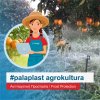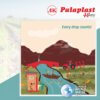
POMEGRANATE (Punica granatum L., Fam. Punicaceae)
Pomegranate is one of the oldest known cultivated trees, which held since ancient times an important place in the daily diet and the efforts of people to deal with diseases. Pomegranate’s name originates from the Latin word “pomum”, which means apple, and “granatum”, which means with seeds. In Greek mythology, pomegranate was related with fertility, prosperity and fruitfulness.
 It is also characterized as a “red treasure”, rich in antioxidants (tannins, anthocyanins) and anti-inflammatory, strengthens the immune system (high content of vitamin C, E, folic acid, iron, potassium, calcium), helps blood circulation, contains Ingredients (ellagic acid, punicalagins) that increase testosterone levels in enhancing male fertility, and finally contributes to good skin health and protection with anti-aging action.
It is also characterized as a “red treasure”, rich in antioxidants (tannins, anthocyanins) and anti-inflammatory, strengthens the immune system (high content of vitamin C, E, folic acid, iron, potassium, calcium), helps blood circulation, contains Ingredients (ellagic acid, punicalagins) that increase testosterone levels in enhancing male fertility, and finally contributes to good skin health and protection with anti-aging action.
Nowadays, the largest share of world production and cultivated land belongs to five countries (India, Iran, China, Turkey and USA), while at the same time countries with lower production such as Spain, Israel and Egypt have contributed significantly to the creation of new varieties, in marketing and also in exports. In Greece there is an ever-increasing dynamics of pomegranate cultivation, which is mainly due to the initiatives of private companies or producer groups that promote cultivation in terms of contract farming, with the main purpose of producing and selling pomegranate juice.
 The pomegranate becomes a shrub or small tree (height 4 to 5 m), but can reach a height of 9 m. Ideal climatic conditions for pomegranate are offered by the areas with hot and long summers (maximum temperature 38⁰C), mild winters where minimum temperature doesn’t fall below -11⁰C, and absence of rain during the fruit ripening stage. Although it has increased adaptability to a variety of environments, it affects the growth of the tree, the flowering, the fruiting and finally the quality of the fruits. Also, the pomegranate adapts to a relatively wide range of soils, with the best growth in deep clay soils, with an excellent pH between 5.5 – 7.0. It can withstand short periods with poor drainage; however, it prefers well-drained soils, as long periods of excessive moisture reduce yields and fruit quality. Regarding the installation of plants, planting distances and the shape of the canopy are the main criteria to ensure good lighting and ventilation between and inside the canopy of trees, maximum yield / acre and good fruit quality. The best time to plant 2-year-old pomegranate seedlings is in late winter. Flowering is observed in late May – early June. The fruits are formed at the top of the branches of the year and ripen from September to October. It enters into fruition from the 3rd – 4th year, while it reaches full production after the 7th – 8th year.
The pomegranate becomes a shrub or small tree (height 4 to 5 m), but can reach a height of 9 m. Ideal climatic conditions for pomegranate are offered by the areas with hot and long summers (maximum temperature 38⁰C), mild winters where minimum temperature doesn’t fall below -11⁰C, and absence of rain during the fruit ripening stage. Although it has increased adaptability to a variety of environments, it affects the growth of the tree, the flowering, the fruiting and finally the quality of the fruits. Also, the pomegranate adapts to a relatively wide range of soils, with the best growth in deep clay soils, with an excellent pH between 5.5 – 7.0. It can withstand short periods with poor drainage; however, it prefers well-drained soils, as long periods of excessive moisture reduce yields and fruit quality. Regarding the installation of plants, planting distances and the shape of the canopy are the main criteria to ensure good lighting and ventilation between and inside the canopy of trees, maximum yield / acre and good fruit quality. The best time to plant 2-year-old pomegranate seedlings is in late winter. Flowering is observed in late May – early June. The fruits are formed at the top of the branches of the year and ripen from September to October. It enters into fruition from the 3rd – 4th year, while it reaches full production after the 7th – 8th year.
Pomegranate trees, although generally resistant to drought, in the orchard need water regularly, throughout all the development stages from flowering until harvesting, to achieve high production and good fruit quality. Excessive perspiration of the leaves during periods of drought will lead to water absorption by the fruits, resulting in reduced production and poor quality. Fruit tearing can also be observed if irrigation occurs after a period of drought, as well as in non-irrigated orchards when there is heavy rainfall after a long period of drought. The irrigation period is defined from flowering to harvest, after which very little irrigation is needed. Pomegranate is among the fruits that do not have the mechanism to ripen after being harvested from the tree, so the fruits should be harvested when they are fully ripe to ensure the best possible taste.
Drip irrigation is considered the most appropriate irrigation system, as it contributes to water economy and to the more complete wetting of the root system.
Palaplast has a wide range of products that can be used for a reliable and efficient drip irrigation system:
- Self-Compensating Drippers : “AXIOS-SC ”
- Irrigation Pipes : “AGROPAL 6atm ”, “DRIP-PAL ”
- Filters : “POSEIDON ”, “Elbow Large ”
- Saddles, such as the New Design “Clamp Saddle 6atm Drawer ”
- Plastic Valves : “Ball Valve”
- Stands
- Indented Fittings: “Indented Coupling”, “Indented Tee ”, “Reducing Indented Tee ” etc.
- Double Rings (3121)


